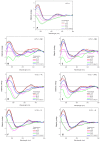The Secondary Structure of a Major Wine Protein is Modified upon Interaction with Polyphenols
- PMID: 32260104
- PMCID: PMC7180857
- DOI: 10.3390/molecules25071646
The Secondary Structure of a Major Wine Protein is Modified upon Interaction with Polyphenols
Abstract
Polyphenols are an important constituent of wines and they are largely studied due to their antioxidant properties and for their effects on wine quality and stability, which is also related to their capacity to bind to proteins. The effects of some selected polyphenols, including procyanidins B1 and B2, tannic acid, quercetin, and rutin, as well as those of a total white wine procyanidin extract on the conformational properties of the major wine protein VVTL1 (Vitis vinifera Thaumatin-Like-1) were investigated by Synchrotron Radiation Circular Dichroism (SRCD). Results showed that VVTL1 interacts with polyphenols as demonstrated by the changes in the secondary (far-UV) and tertiary (near-UV) structures, which were differently affected by different polyphenols. Additionally, polyphenols modified the two melting temperatures (TM) that were found for VVTL1 (32.2 °C and 53.9 °C for the protein alone). The circular dichroism (CD) spectra in the near-UV region revealed an involvement of the aromatic side-chains of the protein in the interaction with phenolics. The data demonstrate the existence of an interaction between polyphenols and VVTL1, which results in modification of its thermal and UV denaturation pattern. This information can be useful in understanding the behavior of wine proteins in presence of polyphenols, thus giving new insights on the phenomena that are involved in wine stability.
Keywords: Synchrotron Radiation Circular Dichroism (SRCD); VVTL1; polyphenols; protein interaction; protein structure; wine.
Conflict of interest statement
The authors declare no conflict of interest.
Figures





References
-
- Han X., Shen T., Lou H.-X. Dietary Polyphenols and Their Biological Significance. Int. J. Mol. Sci. 2007;8:950–988. doi: 10.3390/i8090950. - DOI
-
- Waterhouse A.L., Sacks G., Jeffery D.W. Understanding Wine Chemistry. John Wiley & Sons; Chichester, West Sussex, UK: 2016. Maceration and Extraction of Grape Components; pp. 179–193.
-
- Smith P., McRae J., Bindon K. Impact of winemaking practices on the concentration and composition of tannins in red wine. Aust. J. Grape Wine Res. 2015;21:601–614. doi: 10.1111/ajgw.12188. - DOI
-
- Maury C., Sarni-Manchado P., Lefebvre S., Cheynier V., Moutounet M. Influence of fining with different molecular weight gelatins on proanthocyanidin composition and perception of wines. Am. J. Enol. Vitic. 2001;52:140–145.
-
- Gazzola D., Vincenzi S., Marangon M., Pasini G., Curioni A. Grape seed extract: The first protein-based fining agent endogenous to grapes. Aust. J. Grape Wine Res. 2017;23:215–225. doi: 10.1111/ajgw.12268. - DOI
MeSH terms
Substances
LinkOut - more resources
Full Text Sources

